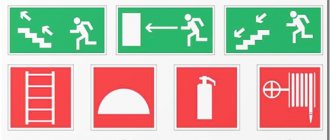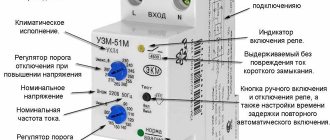Who can be an electrician?
Only a person who has reached the age of majority, with specialized training and a diploma can work as an electrician. In addition, the specialist must have a certificate indicating the electrician’s approval group.
When a person comes to work with electricity, he does not always imagine what kind of risk to life the profession promises. What could be dangerous? Here's what:
- Electric shock when servicing electrical installations and electrical equipment.
- Increased noise level when working in the workshop.
- Falling from height.
- Gas pollution and dust in production areas.
- Work outdoors in any weather, temperature changes in the workshop.
To train personnel in safety precautions, warning posters and electrical safety stands are hung on the walls of the enterprise, and instructions are given.
When the lecture is given, each electrician signs the safety briefing log. Thus, a person takes responsibility for his life and health. If something happens, the installer himself will be to blame.
As you can see, working as an electrician requires increased attention, responsibility and is associated with constant stress.
What current is considered unsafe
Safety precautions when working with a sewing machine Electric current differs in the degree of effect on a person. It is classified as follows: tangible; not letting go; fibrillation. The voltage of the first type of current is 0.6 mA. When struck by this type of current, the victim feels irritation. The second type of current can cause convulsive movements of the muscles of the limbs in contact with exposed wires. The third type of current can cause serious problems in the functioning of the heart. Death from cardiac arrest is possible.
In different situations and under different conditions of the body, the consequences of electric shock can also be different. A current of 15 mA is considered dangerous to humans. In this case, a person cannot free himself from its influence on his own. A current of 50 mA causes serious damage to human health. A current of 100mA for 1-2 seconds can become dangerous and cause cardiac arrest. A current whose frequency is 50-500 Hz is considered dangerous.
Main factors influencing safety Safety precautions when working with electrical appliances The following factors affect the safety of a person using electrical equipment or performing work with electrical equipment: technical condition of electrical installations and devices; method of using devices (organization of work on devices); qualifications of the employee (user); operating conditions of electrical devices in the environment.
Consequences of electric shock.
FAQ
What should you not do when helping a person struck by an electric shock?
When providing first aid to an electrical victim who is still in contact with the conductor, never touch the exposed surface of his body. You will be subjected to exactly the same electric shock and there will be two people in need of help.
Preparatory work
You can’t just come in and start repairing an electrical installation or equipment. There are several points that an electrician must complete before proceeding.
- Wear protective clothing that will protect against electric shock.
- Receive an assignment from your boss. A mechanic can act according to the direction of his boss, but he cannot take the initiative himself.
- Check the lighting in the workplace. It is very important that the work area is well lit; the electrician must take care of this himself.
- Prepare all equipment and tools for work. It’s much more convenient when everything is at hand and you don’t have to look through your pockets and suitcases.
Primary requirements
The list of electrician safety precautions begins with perhaps the most important one—voltage relief. In order to properly de-energize the work area, you need to see a diagram of the area where installation or reconstruction is being carried out. In addition to the diagram, it is important to understand the location of the switching devices (which are needed for disconnection) and the power source of a particular area. First of all, it is necessary to exclude the possibility of turning on the machine or switch.
To do this, the electrician's safety instructions include the following instructions:
- A poster or sign must be posted on the switch handle indicating that the handle must not be touched.
- The same sign is located on the door of the panel or room where the device is located.
- It is necessary to disconnect the wires from the switching parts.
In order for the work to be organized correctly, you need to appoint a responsible person who will monitor compliance with safety regulations. It may not be possible to foresee everything in advance, because there is a human factor, but something can be corrected during the work process.
Why is it important to comply with labor protection requirements?
Occupational safety requirements are an important component of the entire production process. They are enshrined in the norms of federal legislation and are reflected in local acts of the organization. Regardless of the field of activity, there is always a certain risk of injury at work and damage to the enterprise. This is especially true for housing and communal services, schools, and industrial enterprises.
Type of standard instructions in accordance with the law
Working with electricity involves the constant risk of electric shock, which, depending on the strength and voltage of the electrical current, can have harmful consequences.
Note! It is compliance with labor protection requirements and safety precautions for an electrician that makes it possible to minimize or completely avoid such consequences for an employee whose responsibilities include the maintenance and operation of substations or electrical installations and other equipment.
The importance of compliance and measurement of danger are regulated not only by regulations, but also by internal rules of labor discipline, since employees often carry out their activities on expensive equipment, which, if handled incorrectly, can fail or be completely destroyed. That is why such standards serve not only to prevent harm to the health of a citizen, but also to prevent man-made disasters, industrial fires or other emergency situations related to electrical equipment. Also, during the state inspection, the competent authorities conduct a comprehensive study of the knowledge and skills of employees in this area in the form of certification. In case of a negative outcome, such a worker may be removed from his position until re-inspection.
Also, work in this area requires certain skills and knowledge in the field of safety and testing in practical activities. In the process of training or undergoing instruction, as well as receiving a certain rank, an engineer learns the rules for handling installations, carrying out repair work at an enterprise, and the rules for providing first aid. The main document for an employee in the field of safety at an enterprise is his occupational health and safety instructions. This is an internal document drawn up in accordance with federal legislation.
Important! The responsibility for providing primary protective equipment and monitoring compliance with labor safety standards lies with the responsible specialist of the organization, who is appointed by order of management as an important element that carries out fire safety control.
The importance of following safety precautions to avoid injury
Emergency procedures
If the electrician’s safety precautions were violated and a person was electrocuted, then the entire team must provide first aid. What are we talking about?
- The victim must be freed from exposure to electricity.
- The victim must be checked for consciousness, pulse, and breathing. This will help doctors assess the person’s condition.
- Contact an ambulance as quickly as possible.
- If there is no pulse or breathing, then resuscitation measures must be started as soon as possible to restore signs of vitality.
Rules for work
No random person will be allowed to work with electricity. Each installer must have an electrician's license. To get it, you need to graduate from a secondary or higher educational institution, only after that you are allowed to start working.
What should electricians know? The fact that complete safety is achieved only by de-energizing the room. If you simply turn off the light, only one network will be de-energized, but the other wires will carry current.
To be sure to eliminate a threat to life, you need to find the distribution panel and unscrew the fuses on it, and then press the circuit break button. If the shield is linear, then simply lower the lever.
To ensure that the room is de-energized, the electrician must use an indicator screwdriver or power indicator. When the indicator lights up, current is still flowing. In such cases, you need to check how correctly the shutdown was performed. If everything is fine, then you can begin work, while notifying all persons who have access to the shield.
Safety requirements while performing work
3.1. It is allowed to carry out work without removing voltage in electrical installations with a voltage of 500 V and below. These works must be performed by at least two electricians. In this case it is necessary:
– work in dielectric galoshes or standing on an insulating base (insulating stand);
– use tools with insulated handles (screwdrivers must also have an insulated shaft). In the absence of such a tool, it is necessary to use dielectric gloves;
– fence off adjacent live parts that may be accidentally touched with insulating pads (rubber mats, electrical cardboard, micanite sheets, etc.);
– work with the sleeves of clothing lowered and buttoned near the hands and wearing a headdress.
3.2. When carrying out work on live conductive parts, using basic protective insulating means (operational and measuring rods, voltage indicators, insulating and current clamps, etc.), it is necessary:
– use only dry insulating agents with an intact varnish coating;
– hold the insulating means by the grip handles no further than the restrictive ring;
– place the insulating means so that there is no danger of overlapping the insulation surface between the conductive parts of two phases or to the ground.
3.3. When working under voltage, the use of hacksaws, files and metal meters is prohibited.
3.4. If there is a switch, fuse links should be replaced when the voltage is removed. If it is impossible to relieve voltage (for example, on group boards, assemblies), replacement of fuse links is allowed under voltage, but with the load removed; The latter requirement does not apply to fuses with closed fuse links.
3.5. When replacing fuse links under voltage, an electrician must wear safety glasses and dielectric gloves, using insulating pliers.
3.6. An electrician with a qualification of at least group three can replace fuse links, and when replacing at height from stepladders - two electricians, one of whom must have a qualification group of at least three.
3.7. Switching on and off, which is carried out on switchboards, in internal and external networks from stepladders and platforms, as well as where these operations are difficult due to local conditions, must be performed by two electricians, one of whom must have a qualification group of at least three .
3.8. If electrical equipment was turned off at the verbal request of personnel to carry out some work, the next switching on of this equipment can be performed at the request of the person who submitted the request for shutdown, who replaced him, or the authorized person who is replacing him at that time. Before starting up equipment that has been temporarily turned off at the request of personnel, operating personnel must inspect it, make sure it is ready to accept voltage and warn those working on it about turning it on.
3.9. When a ground fault is detected, it is prohibited to approach the fault location within a distance of less than 4-5 m in closed and less than 8-10 m in open switchgears.
3.10. To prevent voltage transformation from the low side to the high side, the low side instrument transformers must be turned off.
3.11. If faults are detected in electrical devices (sparking, flashes, damage to the insulation of electrical wires, cables, etc.), as well as conductive parts left unprotected, the electrician must inform the foreman.
3.12. In areas with increased danger, it is necessary to apply additional security measures, which determine the persons who issue the order or give instructions.
3.13. In fire hazardous premises of all classes it is necessary to use:
– electrical wiring only protected (for example, with wire of the VRG brand, cable or wire PR and PV in steel tubes);
– portable lamps of closed design only. The glass cover must be protected with a steel mesh.
3.14. Lighting fixtures (glass covers, reflectors, metal parts, etc.) and lamps of all types of lighting should be cleaned within the following periods:
– four times a month – in rooms with significant industrial dust emissions;
– twice a month – in rooms with minor industrial dust emissions;
– twice a year – in external installations.
3.15. Dust inside electrical equipment should be removed within the following periods:
– twice a year – for electrical machines with normal sparking parts;
– once every 2-3 months – for electrical equipment installed on mechanisms that experience shaking, vibration, etc.;
– once a year – for other equipment.
3.16. It is prohibited while working in explosive installations:
– repair electrical equipment and networks under voltage;
– operate electrical equipment when the device covers are locked incorrectly;
– turn on an electrical installation that has automatically turned off without identifying and eliminating the reasons for its shutdown;
– overload explosion-proof electrical equipment, wires and cables beyond their rated parameters;
– connect to the power sources of intrinsically safe devices other devices and circles that are not included in the set of these devices;
– leave wide open the doors of rooms and vestibules that separate explosive rooms from other rooms;
– replace burnt-out electric lamps in explosive luminaires with other types of lamps or lamps of higher power than those for which the luminaire is designed;
– replace the protection (thermal elements, fuses, releases) of electrical equipment with other types of protection or protection with other nominal parameters for which this electrical equipment is not designed;
– operate electrical equipment with a low oil level.
3.17. When working at height, on overhead power line poles, or from stepladders or platforms during a power outage, you must ensure that there is no voltage on the line, as well as the strength of the pole. When starting to work on a pole, you need to tie yourself to it with a warning belt and work while standing on both legs. It is forbidden to climb on or off the supports without claws. The specified work is performed by at least two electricians.
3.18. When working from ladders, use light and strong portable ladders and stepladders. The steps must be rectangular and embedded. It is prohibited to use stepladders nailed down without cutting into the steps and without tightening the string with bolts, as well as without sharp metal spikes (when working on soft stands) and rubber tips (when working on hard stands).
The stepladder should not bend under the weight of the electrician. Sliding stepladders must be firmly connected to each other with hooks that do not allow arbitrary sliding apart during work.
Stepladders attached to pipelines must have special hooks at the upper ends for gripping the pipe.
3.19. It is prohibited to use random objects (boxes, barrels, etc.) for stands. It is necessary to use stands of a standard design.
When working with hand tools, do not place them on electrical wires or electrical equipment.
3.20. Use electrified tools (drills, impact wrenches, grinders, etc.) if they are in full working order and at a voltage of no more than 220 V, and in high-risk areas - no more than 42 V.
The body of a power tool that operates at voltages above 42 V (regardless of the frequency) must be grounded. When working with power tools, you must use rubber gloves.
3.21. An electrician should not turn on switches and starter buttons with foreign objects and determine the heating temperature of electrical machines and transformers by touching his hand.
3.22. It is prohibited to remove posters, grounding and fencing without the permission of the work manager.
3.23. Electrical wires should be protected from mechanical damage and from contact with steel ropes, hot surfaces, hoses of gas-flame equipment, oils and acids, which have a destructive effect on the insulation. In damp rooms they should be hung on stands.
3.24. Supply cables and wires should only be spliced by hot soldering, welding or couplings with insulation of the splice points equivalent to the intact insulation of the cables and wires.
3.25. Lamps with fluorescent lamps with a voltage of 220 V are allowed to be installed at a height of at least 2.5 m. At a lower height, they can be installed only if their contact parts are not accessible to accidental touch.
Dielectric tool
To avoid a threat to life, it is important to use the right tools, which include a dielectric tool set. What it is? This is the name for instruments with dielectric handles. If they are marked 1000 Volts, then using the equipment you can service electrical networks.
Attention! When a cable or wire is found to be damaged, it must be replaced. Under no circumstances should you repair the damaged area, as this is fraught with subsequent breakdowns.
All activities related to the maintenance of grounding elements, fuses, distribution boards are carried out only by people who have an electrician’s license. Moreover, even electricians are not allowed to work without the appropriate permits and documents.
Electrical Safety Tips
Thus, you should never forget about precautions; you should use high-quality and serviceable equipment and tools. It is advisable to involve only qualified specialists in repairs or to take on the work competently and in good condition. Also important:
- turn off the plugs on the dashboard before starting repairs;
- post a warning sign;
- check the presence of electricity using a special tester;
- Do not use faulty sockets, sockets, switches and electrical appliances.
It will be interesting➡ What are anode and cathode, what are their practical applications
In bathrooms and other rooms with high humidity, only lamps specifically designed for this purpose can be used. Lamps can only be washed after unplugging the lamp from the socket. And if there are children in the room, you need to be extremely careful and explain to them how to handle electrical equipment.
It is important to remember that the safety of residents and their families depends solely on themselves, be careful, do not rush and do not skimp on light bulbs and wires. And then, if everything is done correctly, electricity will only bring benefits.
Safety at home
Safety instructions for an electrician include not only network maintenance, but also connecting new devices. This is due to the fact that improperly connected household or other equipment can cause a short circuit or simply cause an electric shock.
So, according to GOST standards, the following points must be observed:
- Carefully study the new device before connecting it to the network or carrying out repairs.
- Use metal clips for good fixation.
- Do not connect or use several devices at the same time that consume a lot of energy.
- Do not touch plugged in devices with wet hands or other parts of your body. This is especially true when touching someone in the shower or bathtub.
- If sparking is noticed, you must immediately unplug the device from the outlet.
- Do not pull the cord out of the outlet by the plug.
- Before you start working, you need to remove all jewelry and metal products.
It is especially important not to leave children alone with electrical devices and not to repair them in front of children.
Occupational Health and Safety Instructions
The occupational safety instructions for an electrician are an internal document, which is drawn up by a responsible occupational safety specialist in accordance with federal legislation. This specialist must have certain knowledge and appropriate qualifications in the field of ensuring the safety of other workers when carrying out activities on installations with electric current.
Labor safety instructions for storekeeper
The instruction is a document of strict accountability, which contains the rules of personnel behavior both when working with such equipment and actions in the event of emergency situations.
Note! When carrying out each specific labor action, be it communication with other departments, repair work at substations, the employee must be guided in his activities precisely by the provisions of the internal instructions.
Before starting work
Before starting a work shift at the enterprise, an employee working with installations must undergo a certain type of instruction, which is agreed upon in this instruction. Only after this can the specialist begin work. Also, before starting work, it is necessary to determine the scope of the process task, as well as possible risks associated with electrical current.
During work
While working, the employee must strictly adhere to the instructions and comply with safety requirements. The work process is built from the completion of assigned tasks for the operation, repair or maintenance of electrical equipment. In his work, the specialist must adhere to safety rules, use protective equipment in accordance with the professional category, and ensure safe work for other workers in accordance with these instructions.
Upon completion of work
At the end of the work shift or day, the employee is obliged to inform management about the completion of the assigned tasks, and in the event of emergency situations, immediately, for example, if the network or alarm system fails, inform the occupational safety specialist.
Note! At the end of the day, the worker’s responsibilities include putting a mark in a special logbook indicating that there were no incidents.
In emergency situations
In the event of an emergency, such an employee must be guided by an action plan for evacuation or elimination of negative consequences, which must also be contained in this document.
Visual display of safety rules
Safety rules for on-duty mechanics
It is customary to leave electricians on duty. In this case, the installer must also follow certain rules, namely:
- Monitor the working condition of the protective grounding or grounding.
- Do not connect wires to metal equipment and structures.
- Do not allow electricians to repair equipment or wiring themselves.
- Carry out insulation work efficiently, because if you leave a bare area, an accident may occur.
Rules for working in the city
An important role is played by the categories of electrician in the repair and maintenance of electrical equipment. If a specialist has a low category, then he cannot work with high-voltage lines. What is all this for?
The fact is that in the city the safety rules are somewhat different, and therefore you need to know them in strict order. This is especially true for those who work with electrical installations over 1000 volts.
In addition to knowledge of safety precautions, it is necessary to be able to provide first aid, for example, to free a person under voltage. Special rules are also established for testing and measuring on power cable lines, working with cable masses and a blowtorch, and during rigging work.
If violations are discovered in the operation of equipment or in safety rules, electricians are required to independently take measures to prevent accidents. When this is not possible, management must be notified as soon as possible so that they can take action.
Electricians of city networks, after completing training and confirming their knowledge, receive a qualification group on safety precautions, according to which they work in the future.
So, personnel who work with voltages above 1000 Volts are assigned a certain tolerance group. There are five of them, let’s take a closer look.
- The first group is given to construction workers, electrician apprentices, and general workers.
- The second group includes assistant electricians, electricians, and electricians supervising routes.
- The third group is assigned to electricians and electricians.
- Senior electricians and electricians receive the fourth group.
- The fifth goes to engineers, craftsmen, and technicians.
All work can be performed both with complete and partial blackout.
Please note that in order to obtain an admission group, you must pass an exam.
Safety requirements before starting work
2.1. Before starting work, the electrician must put on special clothing and, if necessary, special shoes and personal protective equipment, checking their service life.
2.2. Check the serviceability of electrical equipment, the condition of insulating stands, grilles, starting devices, grounding, etc.
Check the serviceability of hand tools:
– the handles of wire cutters and pliers must be insulated;
– the working part of the screwdriver must be properly sharpened, and the handle is firmly seated and insulated;
– the wrenches must be in good working order and match the size of the nuts.
It is prohibited to use gaskets or extend wrenches with pipes.
2.3. Hand tools should be stored in a carrying case or a special tool bag.
2.4. Receive a permit or verbal order for the upcoming work.
A verbal order for the upcoming work must be written down in the operational journal. It is noted who gave the order, the place and name of the work, and the deadline for its completion.
2.5. View journal entries about malfunctions and labor protection violations for previous shifts.
2.6. Make sure that switching devices, alarms and interlocks are in working order.
2.7. Check the serviceability of lighting fixtures, electrical wiring and fixtures, lamps. Adjust local lighting so that the work area is well lit and the light does not blind the eyes.
2.8. To prepare the workplace for robots with partial or complete stress relief, it is necessary to carry out the following technical measures:
– carry out the necessary shutdowns and take measures to prevent the supply of voltage to the place of work due to erroneous or arbitrary switching on of switching equipment (install mechanical locking of the leads of switches, switches and disconnectors, insulating gaskets in switches, etc.);
– hang up posters: “Do not turn on - people are working”, “Do not turn on - work on the line”, “Do not open - people are working”, and, if necessary, install a barrier;
– connect portable grounding connections to the grounding device;
– check that there is no voltage on conductive parts that must be grounded;
– ground conductive parts (immediately after checking the absence of voltage), turn on the grounding blades or, if they are not there, apply portable grounding;
– fence off the workplace and hang up posters: “Stop - high voltage!”, “Don’t get in - he’ll kill you!”, “Work here”;
– if necessary, protect live parts that remain live.
2.9. Use a voltage indicator or portable voltmeter to check the absence of voltage in electrical installations up to 1000 V.
2.10. Check that the voltage indicator is working properly and that there is no voltage. In this case, use dielectric gloves.
2.11. Check the presence of grounding of electrical installations at voltages of 500 V and above (replaceable and direct current - in all cases) of electrical equipment housings installed in areas with increased danger, in especially dangerous ones, and in external installations with a rated voltage above 42 V alternating current and 110 V direct current, as well as installed in explosive areas.
2.12. In electrical installations whose design is such that applying grounding is dangerous or impossible (for example, in some distribution boxes, control and distribution devices of certain types, etc.), the following safety measures must be taken when preparing the workplace:
– lock the disconnector lead;
– protect the knives or upper contacts of the disconnectors with rubber caps or rigid covers made of insulating material.
2.13. Parts to be grounded include:
– housings of electrical machines, transformers, devices, lamps;
– drives of electrical devices;
– secondary windings of instrument transformers;
– frames of distribution boards, control panels, panels and cabinets;
– metal structures of switchgears;
– metal cable structures;
– metal casings of cable joints;
– metal shells and armor of control and power cables;
– metal sheaths of wires;
– steel electrical wiring pipes and other structures associated with the installation of electrical equipment;
– metal cases of mobile and portable electrical receivers.
2.14. It is necessary to constantly monitor the reliability of the connection and the serviceability of the grounding device.
It is prohibited to use any conductors for grounding that are not intended for this purpose, as well as to connect grounding connections by twisting.
2.15. When carrying out work on a disconnected part of an electrical installation, grounding is applied to the conductive parts of the phases on all sides from which voltage can be supplied, including reverse transformation.
Grounding must be applied immediately after checking that there is no voltage.
2.16. When using portable grounding cables, before checking them for the absence of voltage, they must be placed near the grounding sites and connected to the ground terminal.
Portable grounding clamps must be applied using dielectric gloves to grounded conductive parts using a rod made of insulating material.
You can fasten the clamps with the same rod or directly with your hands, but you must always use dielectric gloves.
2.17. Removing portable grounding using rods and dielectric gloves must be carried out in the reverse order, that is, first remove it from the conductive parts, and then disconnect it from the grounding device.
The application and removal of portable grounding in installations with voltages above 1000 V must be carried out by two electricians with a qualification group of at least fourth, who are familiar with the electrical installation diagram.
How is the exam taken?
We have already talked in general terms about electrician safety precautions up to 1000 Volts and above, now let’s move on to the exam itself. So why do you need an exam? The fact is that any electrical personnel must have their own safety clearance group.
The exam is held once a year. The venue remains unchanged - Rostekhnadzor. Most often, electricians are examined during working hours, but this question remains at the discretion of the boss.
Let's give an example to make it clearer. If a 4th category electrician takes the exam for an admission group, it is assumed that he already has a 3rd group. That is, he can pass certification to confirm his qualifications and improve them.
How is the exam going? The exam form is familiar to everyone from school - answers to tickets. The applicant enters the office and selects a ticket. The ticket contains nine questions on electrical safety and one on first aid.
It is important to understand that testing takes place annually and is mandatory for all installers who have a clearance group higher than the second. In addition, questions are asked based on the access group for which the electrician is applying.
If the need suddenly arises, an extraordinary examination is held. As a rule, the cause is an accident, the introduction of new standards, an accident, changes in operating mode, or an instruction from an inspector.
If you fail the exam, you have two more attempts to retake it. When they all fail, the electrician is considered unsuitable and is fired. The boss can keep the employee on staff only if the latter failed the test for increasing the qualification group, but passed his exam.
Safety measures during operation and repair of electrical equipment
Inspections of electrical installations. Electrical installations are inspected without removing voltage from them, away from live parts. Defects are detected visually - by inspection and by ear. The right to single-handedly inspect an electrical installation is granted to an attendant with a qualification group of at least III or an administrative and technical employee who has group V in installations with voltages above 1,000 V and group IV in electrical installations with voltages below 1,000 V.
GENERAL SAFETY REQUIREMENTS.
Most of the work is done at height. To prevent falls from a height, it is necessary to use safety devices.
When performing work in electrical installations, serviceable and tested protective equipment must be used. The working crew must be fenced off by signalmen as directed by the work manager. In cases where work is carried out with voltage relief, it must be remembered that in areas electrified with alternating current, life-threatening voltage induced from the suspensions of neighboring tracks arises in the wires of the contact network and overhead lines. Only on a disconnected and grounded line can you work without the use of insulating agents.
Persons at least 18 years of age who have undergone a medical examination, industrial training in safe labor methods, passed exams in the qualification commission and have a certificate of knowledge testing in electrical safety are allowed to work in electrical installations.
When at work, an electrician is required to carry a knowledge test certificate with a warning coupon and present it upon request by workers monitoring compliance with safety requirements.
A warning coupon may be confiscated from an employee by administrative and technical personnel for violating safety requirements. After the withdrawal of a warning coupon, the employee’s knowledge is tested for the issuance of another coupon within two weeks to the extent of the violated sections of this Instruction.
The electrician must be provided with special clothing, special footwear, as well as serviceable, tested protective and installation equipment, and signaling accessories in accordance with established standards.
Responsible for safety when performing work are:
an employee issuing a work order or giving orders to carry out work;
ECC duty officer, issuing an order to carry out work;
responsible work manager;
work producer;
watching;
brigade members.
The work manager supervises the workers and is responsible for the safety of team members during the work process. All technological operations, including movements of team members at the work site, must be carried out only on his command.
The supervisor is responsible for the safety of workers and their compliance with the requirements of instructions for the safe performance of work. When appointed as a supervisor, an electrician is required to maintain constant supervision over the assigned workers, requiring them to implement safety measures.
Each team member is responsible for compliance with these Instructions and local instructions, as well as instructions received during briefing. He must take the necessary measures if he notices a violation committed by other members of the team. During the work process, the team member must follow the instructions of the work manager or supervisor.
Dangerous places, as well as signs, permanent and temporary signal signs, hand signals used on the contact network, are given in the appendix. 3 and 4 to the Instructions.
WORK AT HEIGHT.
Work at height is considered to be all work performed with a rise from ground level to the worker’s feet to a height of 1 m or more. These works can be classified into different categories depending on the specific conditions.
It is forbidden to climb onto a wooden support without checking it for rotting.
Before climbing onto supports, supporting structures and wires, the electrician must visually check their good condition, as well as the presence of grounding. The spark gap or diode grounding switch must first be short-circuited with a shunt jumper with a copper cross-section of at least 50 mm2.
Lifting should be carried out from the field side of the support, and if there are overhead wires and overhead lines on the support, from the sides.
The work should be carried out using a safety belt. It is necessary to attach the carabiner or lanyard of the safety belt to the support, crossbar, cables, wires and other securely fastened structures. In this case, it should be attached in such a way that it is impossible for the worker to approach electrically hazardous elements, even in the event of a fall, at a distance less than that established by the category of work. When securing the full length of the sling with a carabiner, the attachment point should be no lower than the level of the worker’s chest.
During instructions and during work, the work supervisor must indicate in advance to the electrician where the carabiner or safety belt lanyard is to be attached.
You can unfasten the carabiner to attach it to a new place only when there is reliable support at three points, i.e. for two legs and an arm.
It is forbidden to remove the safety belt before completely descending to the ground.
Work should be done in carefully tucked clothes. The soles of shoes must provide reliable grip (not slip) when moving along structures and steps of stairs.
It is prohibited to work simultaneously in several tiers along the same vertical, as well as to be on the ground directly under those working.
Persons who, in case of production necessity, have to be briefly directly under someone working at height, must exercise special caution.
When installing a contact line support, installing consoles or brackets, electricians are prohibited from standing under an unsecured structure, suspended on pulley blocks, or under a moveable structure.
Do not throw tools or materials to anyone working above. They should be served by climbing a ladder or using a rope.
It is allowed to move up and down devices, parts and structures weighing up to 25 kg using a “fishing rod”, and over 25 kg - with a pulley hoist. To prevent the load being lifted from swinging, the worker below must pull it back with the free end of the rope.
It is prohibited to attach ropes intended for lifting loads directly to someone working at height.
To climb onto the support, special “claws”, manholes, and ladders can be used. Before lifting, using “claws” or manholes, you should securely fasten them to your legs and use a sling from the safety belt to cover the support post. The sling should be moved along the support in compliance with the requirements of clause 6.5 of the Instructions.
When working, the “claws” or manholes must be installed so that they are loaded evenly. If manholes or “claws” are the only means of climbing to a support, then the team should have at least two sets of them.
The team must have at least two safety belts.
Fire safety
To maintain fire safety, each enterprise must implement a set of mandatory organizational measures, namely:
determine the responsibilities of officials to ensure fire safety;
have all the necessary types of technical fire protection equipment and other protective equipment available
appoint those responsible for fire safety of individual buildings, structures, premises, areas, technological and engineering equipment, as well as for the maintenance and operation of technical fire protection equipment;
introduce an appropriate fire safety regime;
prepare, approve and familiarize all employees with:
· – general facility instructions on fire safety measures;
· – relevant instructions for all explosion- and fire-hazardous premises;
draw up plans (schemes) for evacuation of people in case of fire;
approve the procedure (system) for notifying people about a fire, familiarize all employees with it;
determine the categories of buildings and premises according to explosion and fire hazards in accordance with the requirements of current regulatory documents, as well as determine the classes of zones according to the “Rules for the Construction of Electrical Installations”;
install appropriate fire safety signs on the territory, in buildings and premises, signs indicating the telephone number and the procedure for calling the fire department.
Particular attention is paid to special measures to prevent fires from the thermal manifestations of electric current.
Internal documents establishing the fire safety regime at the enterprise are developed by those responsible for fire safety and approved by the head of the enterprise. Documents are stored in a special folder on fire safety issues.
The documents should indicate, in particular, the following:
rules for using electric heating household appliances, using open fire, performing temporary fire hazardous work;
smoking area;
the procedure for inspecting and closing premises upon completion of work;
procedure for servicing technical fire protection equipment (fire extinguishers, fire alarm systems, automatic fire extinguishing systems, smoke absorbers, self-rescuers and other fire protection equipment);
responsible persons who must conduct special training and instructions to personnel on fire safety issues, and the frequency of these activities;
actions to be taken by employees in the event of a fire
. The list of documents may be different for each enterprise. The main documents required by the fire authorities are given below:
Order(s) on the appointment of those responsible for fire safety of individual buildings, structures, premises and extensions;
An order (corresponding provision) on the procedure according to which special training and instructions should be provided to employees, and their knowledge on fire safety issues should be tested;
Program for conducting introductory fire safety training;
Program for conducting initial fire safety training;
A list of questions on which knowledge should be tested after initial, repeated and unscheduled fire safety briefings;
Logbook for registration of briefings on fire safety issues;
Expert opinion (expert opinions) regarding the correctness and completeness of the implementation of fire safety requirements in the design and estimate documentation for construction, reconstruction, technical re-equipment of production and other facilities, introduction of new technologies;
Permission(s) for the start of operation of each newly created enterprise, the commissioning of new and reconstructed facilities, for the introduction of new technologies, the launch into production of new fire-hazardous machines, equipment and products, for the rental of any premises, buildings and structures;
Certificate(s) of conformity for all types of fire fighting equipment and equipment;
List of responsibilities of officials to ensure fire safety;
Orders, instructions establishing the appropriate fire safety regime;
General facility instructions on fire safety measures;
Instructions on fire safety measures for all explosive and fire hazardous premises (areas, workshops, warehouses, workshops, laboratories and others);
Plans (schemes) for evacuation of people in case of fire;
Instructions for security workers (security guards, watchmen, guards, duty officers);
A list of company officials compiled specifically for security workers, in which (the list) the home address, business and home telephone numbers of each of these persons should be indicated;
Schedules and reports of measurements of insulation resistance of electrical networks and electrical equipment;
Documentation, the list of which is given in the “Rules for the technical maintenance of fire automatic installations”;
Regulations for the maintenance of fire automatic systems, fire warning systems, fire extinguishers;
Schedules and reports for checking the resistance of grounding devices;
Work permits for performing hot work.
The fire safety folder should also contain documents about voluntary fire brigades, fire technical commissions, and the operation of fire automatic systems (if the enterprise has them).
We draw your attention to two items from the above list - instructions and evacuation plans; such documents should usually be posted in a visible place.
Each enterprise must have general (for all facilities) instructions and instructions for all explosion- and fire-hazardous premises (areas, workshops, warehouses, workshops, laboratories, etc.). All employees of the enterprise must familiarize themselves with these documents during fire safety briefings, fire-technical “minimum”, and industrial training. Instructions must be posted in prominent places throughout the facility. Each instruction must be recorded in the appropriate journal.
If the enterprise is located in a two-story building or higher, if more than 25 people are in it at the same time, then you must hang plans (schemes) for evacuation of people in case of fire in visible places.
The employee who prepared the evacuation plan must sign it, and the head of the enterprise must approve it with the fire authorities.
All company employees must undergo fire safety training. Each fire safety briefing, except for the targeted one (before temporary fire work), must be recorded in a special log.
The procedure for special training, instruction and testing of knowledge of enterprise employees is determined by order of the head of the enterprise, based on the recommendations of the fire inspection staff that you have chosen.
All buildings, production and warehouse premises, as well as laboratories, must be divided into categories of explosion and fire hazard, and also be divided geographically into zones by class in accordance with the Electrical Installation Rules.
The designation of the category and class of the zone is indicated on the entrance doors to the premises, as well as on the boundaries of the zones - indoors and outdoors.
In addition, inside the building, in prominent places near telephones, signs indicating the telephone number of the fire department are placed.
Special signs must indicate where fire extinguishers are installed. Such signs are attached in visible places at a height of 2.0–2.5 m from the floor inside and outside the premises. Important to remember:
A necessary condition for meeting the requirements of fire safety standards and regulations is the installation of fire safety signs in rooms, buildings, and structures that comply with GOST. Such signs should warn employees of possible danger and provide the necessary information about actions in the event of a fire.
On the territory of those facilities where smoking is permitted, the administration must identify and equip a special place for smoking. An appropriate sign or inscription is installed there, as well as a trash can or ashtray made of non-combustible materials.
However, please remember that some facilities are non-smoking. These include:
facilities (their territory and premises) for the extraction, processing and storage of flammable substances, combustible materials and flammable gases, for the production of explosives;
buildings containing explosion- and fire-hazardous premises (areas), commercial enterprises, warehouses and bases;
premises of preschool, school and medical institutions;
grain and cereal arrays and grain collection points.
CONCLUSION
The topic of this thesis is the electrical equipment of a specialized screw-cutting lathe with increased model accuracy (your machine). During the work, the following issues were considered:
— purpose and design of the machine;
— maintenance of electrical equipment;
— repair of electrical equipment components;
— grounding of electrical equipment.
A calculation and selection of wires and fuse links was carried out. The operating principle of the electrical circuit diagram of the machine is described in detail. Attention is paid to occupational health and safety. The topic of this thesis is relevant, since this machine is widely used in production.
Dielectric tools
Usually a person far from electricity cannot name any special tools other than a set of dielectric screwdrivers. In fact, there are quite a lot of them, because the work requires specific devices. Let's take a closer look.
How does a dielectric tool differ from a regular one? It has a moisture-proof insulation layer and good electrical resistance. The device must be resistant to acids, oils, and gasoline. The strength of the tool is no less important; it must withstand falls, including from great heights.
As for the set of dielectric screwdrivers, their handles should be long (from 10 centimeters) and well insulated. Long rods must be insulated up to the working length, and short ones must have stops that prevent the tool from slipping out of your hands. Typically handles are made of plastic, hard rubber or rubber.
The handles of wire cutters, pliers and other tools are also protected. So that the tools can be used not only by electricians, but also by representatives of other professions, dielectric covers are made on the handles, which are easily removed. An electrician can work without problems, because the covers do not slip and have stops. And if someone else needs the tool, he will simply remove the covers and use it. It is especially convenient that if damaged, it is enough to simply change the covers.
Protective equipment includes insulated tools, special dielectric gloves and voltage indicators. They are most in demand for panel work up to 1000 V with the voltage turned on.
We should also talk about dielectric gloves. Safety precautions at the workplace of an electrician of any category require the presence of dielectric gloves. Typically, they are made of latex. A mandatory mark is a stamp indicating the test date; it is important that the deadline is met. Before work, gloves are checked for integrity; the easiest way to do this is to inflate them with air. The gloves have a socket that needs to be tightened; if the pressure drops, the gloves are unsuitable. Put gloves on over the sleeves.
Voltage indicators are also necessary for electricians in their work. They are divided into double-pole and single-pole. With their help, it is not the magnitude of the voltage that is determined, but its presence. The devices have lights that light up when there is voltage. The single-pole version resembles a screwdriver with an indicator and an upper finger contact. The current is connected to the ground through the finger. The safe ignition voltage should not exceed 90 V, and the current should not exceed 0.6 mA.
Bipolar indicators are a pair of probes connected to each other by a wire. One of the probes is equipped with a light bulb, which lights up from time to time. To check the voltage, you need to attach one of the probes to the object being tested, and the other to the ground. To eliminate errors, check the indicators on an object that is energized before work.
There is also a special tester that shows the voltage and current values. The device is not only pointer, but also digital.
We remind you that before work you must check the integrity of each tool and its serviceability. If you do not do this, you can endanger not only your life, but also the lives of other people.
The effect of electric current on the human body
- Thermal impact. This is heating of human body tissues and burns.
- Electrolytic effect of current. This is an effect on the blood and other body fluids, causing the decomposition of their constituent elements.
- Biological (physiological) effects. Irritation and excitation of muscle and nervous tissue occurs, which leads to convulsive muscle contractions. The most dangerous contractions of the heart muscle and lungs
The result of these impacts can be divided into two types of electric shocks: electrical injuries and electrical shocks. Electrical injuries are clearly defined local tissue damage. Injuries include electrical burns, electrical marks, skin metallization, electroophthalmia, and mechanical injuries.
Material on the topic: What is the danger of resonance and what kind of phenomenon is it.
Burns. A consequence of the thermal effect of current passing through the human body, or touching very hot parts of electrical equipment, or from the action of an electric arc. The most severe burns occur when an electric arc occurs in networks of 35–220 kV and in networks of 6–10 kV with high network capacity. In these networks, burns are the main and most severe types of damage. In networks with voltages up to 1000 V, burns from an electric arc are also possible (when the circuit is disconnected with open switches in the presence of a large inductive load).
What is the difference between parallel and series connection of capacitors?
Read more
Do-it-yourself pirate metal detector - detailed instructions.
Read more
What is a tuning resistor: description of the device and its scope.
Read more
Electrical marks are clearly defined skin lesions where the electrodes come into contact. They can be round or elliptical in shape, gray or white-yellow in color with clearly defined edges. Caused by the mechanical and chemical effects of current. They can appear only some time after exposure to current. Usually the lesions are not accompanied by inflammation and pain, but cause swelling and swelling at the site of contact with the electrodes. Signs of a small area heal safely, but with a large area of lesions, tissue necrosis occurs.
Electrician safety precautions.
Electrometallization of the skin is the penetration of the smallest particles of metal into the upper layers of the skin due to its boiling and splashing under the influence of an electric arc. The damaged area of the skin becomes hard and has a rough surface. A sensation of a foreign body appears at the site of the lesion. The outcome of the injury, as with a burn, depends on the area of the affected area. Most often, metallic leather comes off without leaving a trace.
Electroophthalmia is an inflammation of the outer membranes of the eyes, resulting from strong exposure to ultraviolet rays released during the burning of an electric arc.
Mechanical damage - Bone fractures and ruptures of tendons and muscles caused by muscle contraction when current passes through them. They are the result of an electric shock.
An electric shock is the result of the biological effect of current, consisting in the excitation of nerve tissue when an electric current passes through the body. Manifested by involuntary convulsive muscle contractions.
It is important to know: What is electric current.
There are four degrees of electric shock depending on the outcome of the impact on the body, ranging from mild, without loss of consciousness (first degree) to clinical death (fourth degree). In a state of clinical death, a person has no breathing or heartbeat, the pupils of the eyes are dilated and do not react to light. The duration of clinical death is approximately 4-8 minutes. After this time, the death of brain cells occurs, leading to the irreversible cessation of biological processes in the body, the collapse of protein structures - biological death.
How dangerous is electric shock?
Current in the human body
The most dangerous is the passage of current through the respiratory organs and heart along the longitudinal axis (from head to feet). Proportion of total current passing through the heart:
- hand-to-hand path – 3.3% of the total current;
- path left hand - legs - 3.7% of the total current;
- path right hand - legs - 6.7% of the total current;
- leg-leg path – 0.4% of the total current.
It will be interesting➡ What is a trigger in electronics - we understand the terms in detail
At voltages up to 250-300 V, alternating current with a frequency of 50 Hz is approximately 45 times safer than direct current; at higher voltages, direct current is more dangerous. A current is considered safe if its prolonged passage through the human body does not cause harm and does not cause any sensations. Its value does not exceed 50 μA. A current between 0.5 mA and 1.5 mA is called the threshold sensible current. It causes a slight tingling sensation, a sensation of heating the skin. At a current of 2-5 mA, pain in the hand and trembling of the hand appear.
Possibility of death from electric shock.
Increasing the current to 10-15 mA causes unbearable pain and complete cessation of muscle control. If a person simply touches live areas, he can free himself from the action of the current by withdrawing his hand. If the wire is clamped in the hand, then at this current value the person cannot voluntarily release his fingers from the live parts and remains under voltage.
For this reason, a current greater than 10-15 mA is called non-releasing. This phenomenon is explained by the fact that if a current of the same magnitude passes through the muscles that control the flexion and extension of the fingers.
Table - Average values of threshold currents.
The flexor muscles, being more powerful, create a slightly greater force, so the fingers are clenched into a fist. When an industrial frequency current of up to 10-15 mA passes through the arm, the influence of biological impulses at the will of a person can still create a greater force in the extensor muscles than in the flexor muscles, and the victim can be freed from the action of the electric current. With a higher current, the effect of biological impulses on muscle control is completely lost and their contraction is determined only by the action of an external current.
A threshold non-releasing current can conditionally be considered safe for humans in the sense that it does not cause immediate damage. But with prolonged passage, the magnitude of the current increases due to a decrease in body resistance, which can result in circulatory and respiratory problems and death.
At a current of about 50 mA, a convulsive contraction of the chest muscles begins, constriction of blood vessels and an increase in blood pressure, which leads to loss of consciousness and death. When a current of more than 100 mA passes along the path arm - arm or arm - legs for 2 - 3 seconds, it leads to death (lethal current).
Since after 1-2 seconds cardiac fibrillation may occur (chaotic, scattered contractions of individual fibers of the heart muscle). As a result, the heart stops working and blood circulation is impaired. Fibrillation continues even after the current stops, resulting in death.










